CHOOSING A CAR STACKER
CHOOSING A CAR STACKER
Asking the necessary questions to choosing the correct parking system
In today’s fast-growing world, the need for car stackers is growing, and it’s all based on limited space. It could be a car-enthusiast wanting to store his Corvette in his garage over the wintertime, or a developer or architect firm looking to utilize more parking spaces in a dense, urban environment. The range of applications for car stackers can vary greatly; here are some points to consider when picking out the right piece of equipment.

Application – Is it indoor or outdoor? Is it residential or commercial? These first two questions dictate which category (and quality) of equipment you should be considering. Some manufacturers offer specific accessories for outdoor use. OMER offers a fully hot-dipped galvanized lift structure, made for longevity in a true outdoor environment.
One must also understand the use & demands of their lift. Use will vary greatly when comparing residential & commercial applications. The market for residential car stackers includes 4-post style, chain & pully operated systems. These drive systems are effective for storing a car for an extended time, but they are not intended for frequent use. In addition, cable & pully driven lifts will require inspection and maintenance/re-tensioning of the system. Some residential car lifts will also have limited locking positions. Commercial environments can include valet operated parking lots for businesses such as restaurants, condominiums or apartment complexes. The market for commercial users will most always incorporate a hydraulic system (OMER’s Bipark utilizing a twin-cylinder design) for equalization. When making your decision, consider the amount of “cycles” your car stacker will see. OMER’s Bipark incorporates a geared rack & pinion drive system, interlocking the columns and platform with a torsion bar. This design allows for intensive use in “high-cycle” environments.
Now that we’ve determined our application, we can consider the footprint & space of the equipment. Some car stackers will feature “low-clearance” models, capable of fitting into some residential garages. When considering the footprint of the equipment, also consider the heights (or range of heights) your vehicles will be. Most taller vehicles & SUV’s will require a certain height to be achieved, to park under the platform. In addition, some car stacker manufacturers will have limited locking positions available, further restricting your use of space. In addition to space available, also consider utilities available. Power requirements can vary. Typically, residential users will be considering a 1-phase, 220V product, while commercial environments are more typical with 3-phase power. 3-phase power will also increase the speed of the lift’s operation by roughly 30%. While typically reserved for the entry level equipment, some lifts will require compressed air for the locking mechanisms.
Finally, all users should consider the cost-of-ownership of their equipment. Less expensive parking systems are enticing with the initial “buy” price, but they require more maintenance & inspections.
OMER’s Bipark car stacker appeals to both the residential and commercial user. Engineered, designed & manufactured in Italy, OMER’s Bipark is everything you’d expect from a quality European-made product. Incorporating a 2-post, space maximizing design, OMER’s Bipark can increase useable space in a car enthusiasts’ garage, or in a crowded outdoor metropolitan parking lot.
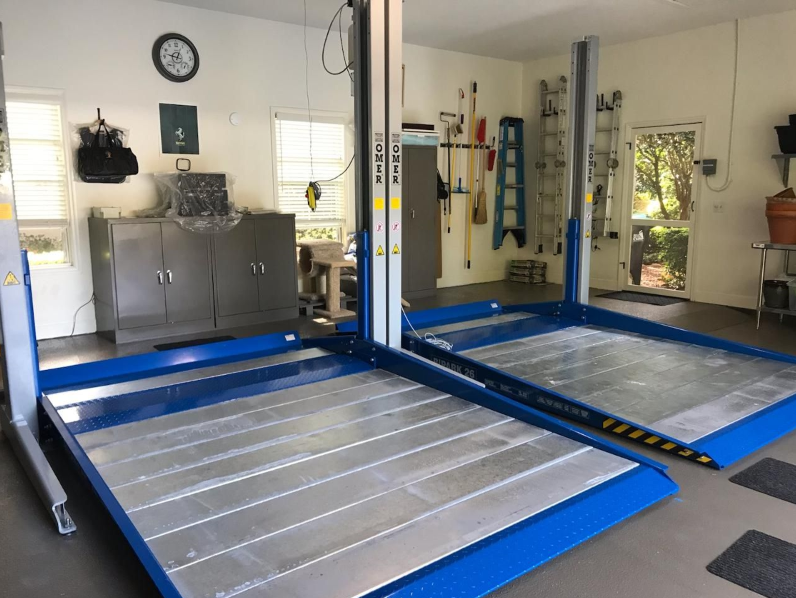
The Best Car Lift For Your Home Garage Is The Best Lift That Will Fit
The Best Car Lift For Your Home Garage Is The Best Lift That Will Fit

The best car lift for a home garage is a commercial grade 2-post or 4-post lift, which is why they’re used in just about every vehicle repair shop in the world. The trouble is, these lifts don’t always fit in a home garage.
In fact, most of the time, commercial lifts do NOT fit in home garages. A commercial lift needs 11 foot ceilings and an extra-wide garage space (in terms of width). Most garages don’t have that kind of space.
So, the question is not “What’s the best car lift for a home garage?,” but rather “What’s the best lift that will fit in my home garage?”
The Best Home Garage Car Lift Is Safe, Straightforward, and Works With Almost Any Kind of Car
If you want the best car lift for your home garage, there are four features you absolutely need:
Safety. A lift that can fail during raising or lowering is dangerous. A lift that doesn’t properly secure a vehicle is life-threatening. Many of the lifts on the market today have problems with tipping front-to-back (because they lift a car between the wheels) as well as failures during raise and lower (because they use independent hydraulic mechanisms).
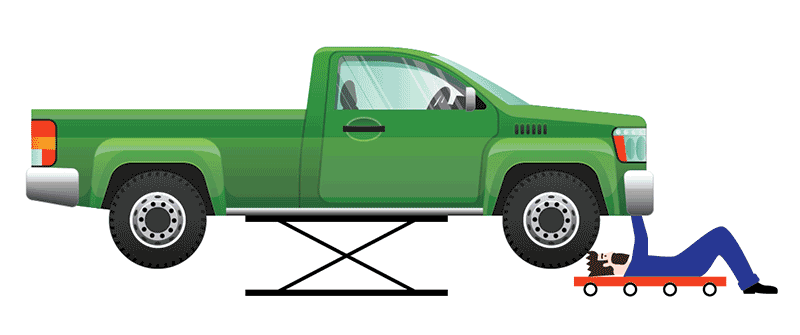
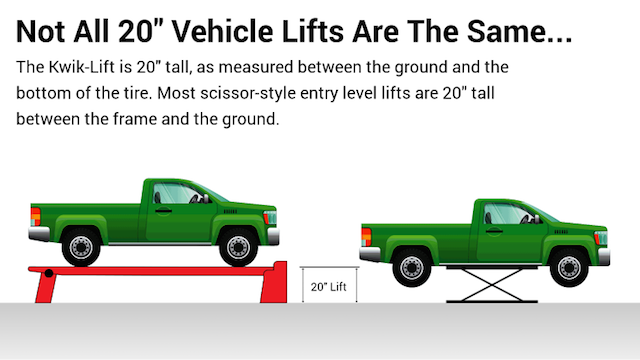
Simple, straightforward design. When you have time to work on your vehicle, the last thing you want to be doing is inspecting your lift, replacing fluid and looking for leaks, checking air cylinder pressures, or doing leak clean-up.
Unfortunately, most of the entry-level hydraulic lifts on the market have precisely these problems. This is because cheap hydraulics are infamous for random, unexplained fluid leaks and problems…and you can’t buy a cheap hydraulic car lift without getting cheap hydraulics!
Nearly universal vehicle compatibility. If you’re serious enough to invest in a vehicle lift, odds are you need a lift that works with nearly any type of vehicle. Who needs a lift with an absurdly low 3,500lbs weight limit? Or a lift that only works if a vehicle has 5″ of ground clearance? Or a lift that isn’t compatible with classic cars that don’t have unibody frames?
True portability, or park on top convenience. If your garage looks like most people’s garage, there’s not a lot of ‘extra’ space for your lift. So, you need a lift that you can other disassemble and stow away, or you need a lift you can easily park on top of.
DIY Car Lift? Probably Not A Good Idea
DIY Car Lift? Probably Not A Good Idea
If you’re entertaining the idea of building a DIY lift, this article is for you. There are two different kinds of DIY car lifts:
Fabricated steel lifts built with the best of intentions.
Lifts that use a combination of inexpensive tools to get a car in the air.
Let’s talk about both types of DIY car lifts and why it’s a good idea to approach either project with caution.
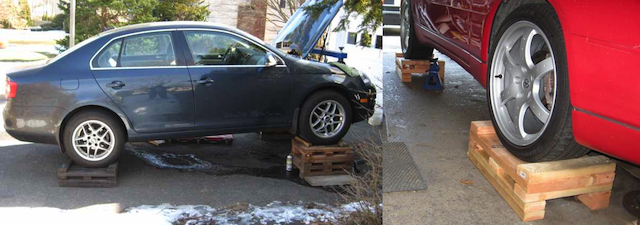
Do you have some steel fabrication knowledge and experience? Building something like a vehicle lift from scratch is a tempting idea. Take some steel, fabricate something, and have a nice little vehicle lift for personal use. There are some examples of people building lifts of their own this way, and you can find pictures and even plans online.
But here’s the thing: when it comes to vehicle lifts, safety and cost are usually related. If you build an inexpensive steel lift without sufficient strength or stability, it will be cheap but not very safe. If you build something with lots of extra support and excellent strength, it will cost you almost as much as a brand new lift. And, and the new lift would be:
Guaranteed to support a vehicle safely.
Expected to last a while (or forever if you get a Kwik-Lift).
Backed by a warranty.
This isn’t to say that a person with sufficient skill and time can’t fabricate a great vehicle lift for themselves. It’s just to point out that, as a lift manufacturer for more than 20 years, we’ve seen a lot of home garage lift manufacturers come and go. Most of the lift companies that have gone out of business came up with designs that were either:
- Unsafe.
- Difficult to use.
- HIgh-maintenance.
- Unreliable.
- Or all of the above.
And it’s not as if these companies were fly-by-night operations backed by inexperienced people. Name brand commercial lift manufacturers have tried to offer vehicle lifts for home garage use, and most of them have failed. Even today, a name brand lift manufacturer is offering an entry level hydraulic lift that – while cleverly marketed – has a lot of severe limitations.
Basically, building a safe and easy to use steel lift cheaply is hard. If you set out to build something like the Kwik-Lift, odds are good you’d end up with a lift that cost roughly the same to build as our product. But without all the nice little features that make our lift so easy to use.
Fabricating Your Own Steel Car Lift
Another type of DIY lift is made using a combination of ramps, wheel stands, and jack stands. There are a couple of positives:
You can often buy all the ramps and parts you need for a few hundred dollars.
Assuming you buy good quality products, you can rest assured that your vehicle is safely in the air.
However, there are a couple of negatives – time and lift height.
Car Storage Lifts vs. Garage Expansion
Car Storage Lifts vs. Garage Expansion
A one-car garage is for a single vehicle, a two-car space is for two, a three is for three, and so and so on, right? However, it’s not always the case! If your garage is overcrowded with clutter or you can only park one vehicle in at a time, it’s time to make some changes. But should you go for a storage lift or a bigger garage?
Your initial thought may be to expand the one piece of your house, but if you invest in a four-post car lift, you can double the available parking space without a massive renovation. It’s a practical solution that saves time and money. While expansion may be necessary for some scenarios, you can upgrade the functionality of your space by relying on the convenient and affordable lifts offered at North American Auto Equipment.
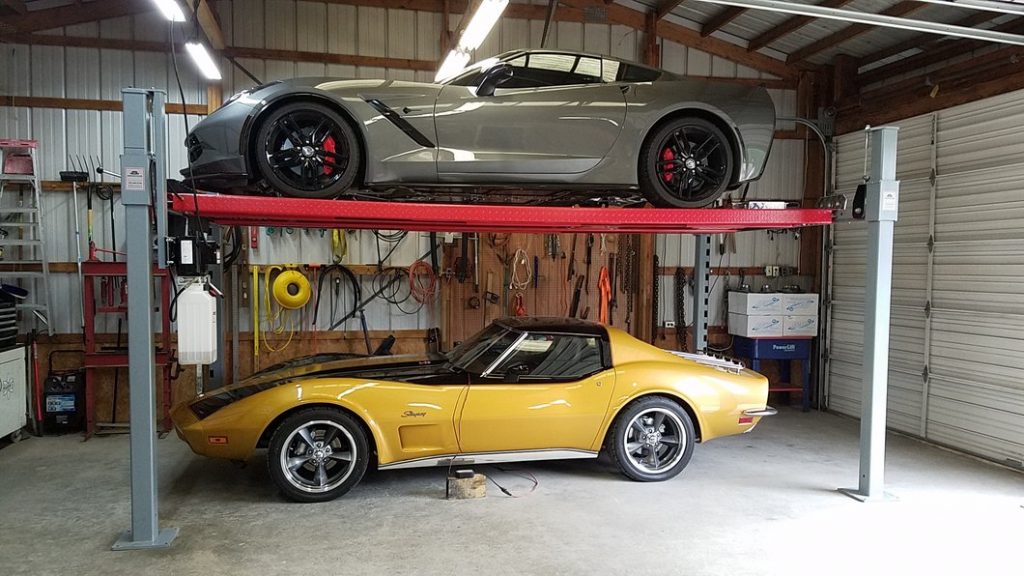
Advantages of a Four-Post Automobile Lift
A four-post car lift gives you the ability to elevate a vehicle upward to optimize your garage space. It uses a hydraulic system to take the utmost advantage of the vertical space. When you lift one car, you can park a second vehicle underneath.
But why rely on a lift compared to a full renovation? For starters, renovating will result in higher costs and includes complicated logistics and planning. You’ll also end up with less yard space and live with an extended construction zone in your yard for several weeks or months — and rebuilding is a more significant commitment.
Knocking down walls and rebuilding may be a good idea if your collection of cars is growing by the year, but for the average car owner, an auto storage lift makes more sense in the long run. They take less time to install, cost less money and are more convenient during the constructing process. Lifts use the space you already have as opposed to creating a new area, making it efficient.
Advantages of a Four-Post Automobile Lift
What’s excellent about lift equipment is that you can use it to store more than a vehicle, such as:
- Bicycles
- Boating Equipment
- Lawn Mowers
- Motorcycles
- Snowmobiles
While some may require attachments, you can store dozens of various items. A car lift is also ideal for maintenance and repairs if you’re a DIY mechanic, allowing you to stand or sit under your car while working on the suspension, transmission, alignment or other components. Make sure to buy one that’s ALI certified, too. The lifts protect your truck or car from the elements and other potential threats as opposed to sitting in a driveway. They are also more cost-effective and convenient compared to storage units.
